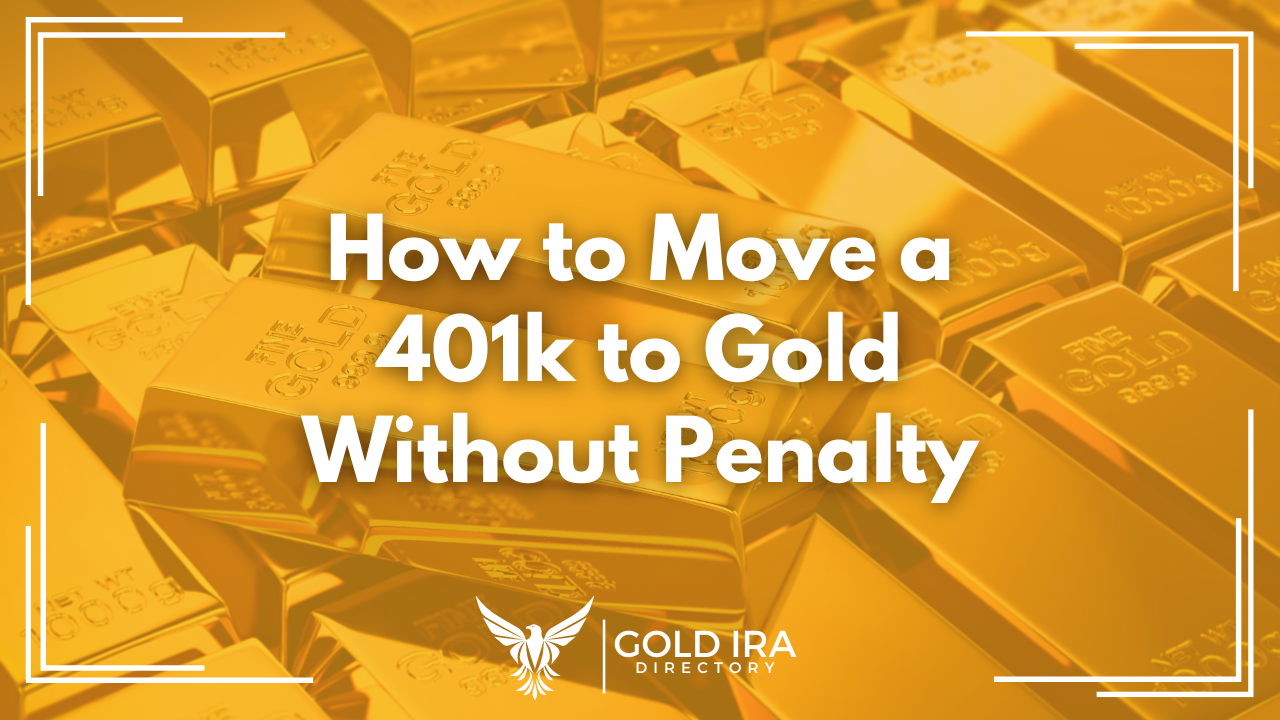
A lot of investors are considering if it’s a good idea to transfer their 401k into a Gold IRA. Investing in precious metals like gold and silver offers numerous advantages. Individual retirement accounts provide an additional layer of security for individuals approaching or currently in retirement. A Gold IRA provides the opportunity to invest in tangible gold, something that’s not possible with a conventional 401k account.
Find the Best Gold IRA Company of Your State
Investing in a Gold IRA offers numerous advantages. One option is to invest in physical gold and silver, which can enhance the diversity of your investment portfolio. Moreover, Gold IRAs generally offer greater stability compared to traditional paper investments such as stocks or bonds.
Secondly, gold and other precious metals have consistently proven to be a reliable investment for safeguarding against inflation. This is a significant matter to consider, as the inflation rate in America has reached its highest point in four decades, standing at 9.1% according to the Consumer Price Index from June 2021 to 2022. Finally, IRAs provide an opportunity to invest while keeping your tax burden low, which will come into play when you reach retirement age.
Should you possess a 401k, rolling over the funds into a Gold IRA is a straightforward process, provided you adhere to the regulations set forth by the Internal Revenue Service (IRS). To simplify things further, there are expert Gold IRA firms that will take care of all the paperwork on your behalf!
This is a detailed guide on how to transfer your 401k into a Gold IRA, featuring evaluations of the top companies available for this process.
What is a Gold IRA?

A Gold IRA is a type of individual retirement account that allows you to invest in physical gold and other precious metals as part of your retirement savings strategy.
Before you put your money into a Gold IRA, let’s ensure you grasp what it entails. An IRA that invests in physical precious metals is often referred to as a “Gold” IRA, but it can also encompass silver, platinum, or palladium as part of the investment portfolio.
Valuable metals IRAs are a form of self-directed IRA (SDIRA), indicating that the individual holding the account is in charge of selecting the investments. This is different from other kinds of investment accounts, like mutual funds or exchange-traded funds (ETFs), where a fund manager is responsible for making investment choices for all the account holders.
A self-directed IRA gives you greater flexibility in selecting your investment options. You’re not confined to conventional investments such as stocks and bonds. Investing in other assets, like real estate or privately held companies, is also an option to consider.
401k accounts generally provide a rather narrow selection of investment options, often limited to just three or four mutual funds. On the other hand, a self-directed IRA allows for investment in a wide variety of assets, such as:
- Precious metals like gold and others
- Property market
- Investments in private equity and venture capital
- Collaborative business arrangements and partnerships
- Uncultivated or agricultural property
- IOUs
The SDIRA offers a solid opportunity for investing your funds, though it’s important to note that collectibles are not included.
What Makes Gold a Wise Investment?
In these times of rising inflation and uncertain economic conditions, more and more investors are turning to gold and silver for reassurance. Gold has proven to be a reliable store of value against inflationary pressures, outperforming many other financial assets.
There’s a common notion that an ounce of gold will always be sufficient to purchase a well-tailored suit. This was accurate when gold was priced at $35 per ounce, and it largely remains the case today, with its value ranging from $1,500 to $2,000.
While the economy and stock market experience their ups and downs, gold has consistently maintained its value – it has never completely lost its worth. It’s important to remember that as various paper currencies rise and fall…

Investing in gold can be an attractive option for safeguarding one’s finances during economic downturns and inflation, especially as one approaches retirement. A Gold IRA serves as a safeguard for your retirement savings, helping to preserve its value over time.
Expanding your investment portfolio is a wise approach to minimize risk and fluctuations, and one method to achieve this is by putting your money into gold, silver, and other precious metals. The price changes of these assets don’t closely align with the overall stock market, making them a useful tool for balancing your portfolio during times when stock values are declining.
Also read: Gold IRA Tax Rules
The Benefits of Having Physical Gold
There are several methods to invest in gold and other metals, such as purchasing stocks in mining companies, acquiring physical coins, or investing in ETFs or mutual funds. Nonetheless, putting your money into a Gold IRA offers numerous benefits compared to paper assets like gold stocks or ETFs.
There are a number of reasons why investing in physical gold makes sense.
An increasing number of individuals face the threat of identity theft or online hacking. If you’re in search of a reliable investment, gold stands out as a solid choice since it offers a level of security that is hard to undermine.
One significant benefit of possessing physical gold investments is the ability to do so without revealing your identity—a vital aspect in our current society, where many individuals are rightly worried about government interference. It’s unfortunate, but it’s quite simple for governments to take control of funds held in a bank account. In 2013, a significant number of citizens in Cyprus found themselves taken by surprise when, in reaction to an economic crisis, the central bank took millions of dollars from their accounts overnight.
Gold not only provides a safeguard against government seizure, but it also offers greater protection from creditors compared to cash. This makes gold an appealing investment for numerous individuals.
In contrast to stocks, which can be quite vexing due to their reliance on the actions of others, like a company’s board of directors, investing in physical gold eliminates any concerns about counterparty risk. The value of gold stands on its own, unaffected by the actions of others. This means your investment isn’t at the mercy of a fund manager who could potentially bring it down.
Additionally, the physical gold or silver, along with platinum or palladium, that you hold in a precious metals IRA provides you with significant tax benefits associated with all IRAs.
Contributions to a traditional IRA lower your taxable income for the year, and any investment gains are taxed only when you start taking withdrawals. A Roth IRA provides the opportunity to earn profits without the burden of taxes, and you have the flexibility to buy or sell gold and silver as often as you like, without the concern of triggering taxable capital gains.
The Roth IRA: An Ideal Savings Choice for Investing in Gold
Your financial situation and your vision for retirement will guide you in establishing your Gold IRA. You have options such as a traditional IRA, SEP IRA, Spousal IRA, or Roth IRA to consider.
If you believe your tax bracket will be lower in retirement compared to now, then establishing a traditional IRA could be a more sensible choice. If you think your taxes might increase during retirement, a Roth IRA could be more advantageous for you, as it allows you to avoid taxes on all the capital gains it generates.
While it may seem like a disadvantage not to receive tax benefits when contributing to a Roth IRA, this is often outweighed by the significant tax advantage of allowing your Roth IRA to grow without being taxed on capital gains, provided you wait at least five years before making any withdrawals from the account.
Various Methods to Increase Your Roth IRA Funds – A Detailed Explanation with an Example
Investing in a Roth Gold IRA could lead to significant profits if gold prices increase substantially before you begin making withdrawals, all while avoiding any taxes on your capital gains.
For instance, if you put in a total of $100,000 into a Roth Gold IRA over the years, and if gold’s value were to appreciate by 500%, this is what might occur: (It’s not as far-fetched as it may appear. In the first two decades of this century, gold prices increased from approximately $300 to over $2,000.
Numerous market analysts are of the opinion that the price of gold is likely to keep climbing over the next ten years, potentially hitting values ranging from $5,000 to $10,000 per ounce. So, if you put 100 thousand dollars into gold via your Roth IRA account today, it might be worth around half a million dollars in 10 to 15 years. The most advantageous aspect is that, given this return on investment originates from a Roth IRA account, all the profits accrued will be free from taxes! This extra income won’t increase your tax burden or jeopardize your eligibility for financial assistance programs such as Medicaid.
Several additional factors contribute to the attractiveness of Roth IRAs for investors compared to other alternatives, including traditional IRAs. For instance, you aren’t obligated to take “required minimum distributions” (RMDs) from a Roth IRA at age 70 and a half, unlike with a traditional IRA. If necessary, you can simply let your Roth Gold IRA grow in value without making any withdrawals until after you pass away, at which point it can be inherited by your children.

It’s interesting to note that if you’re looking to tap into your retirement savings before hitting 59 and a half, the guidelines for making a penalty-free withdrawal from a Roth IRA are quite a bit more flexible compared to those for a traditional IRA. You can make a withdrawal without penalties for costs associated with purchasing your first home or funding your education.
Transferring a 401k to a Gold IRA Relocate your 401k to gold without incurring penalties
A Gold IRA rollover happens when you set up a new retirement account by moving funds from an existing one, such as a 401k or another IRA. You are transferring the funds into a different retirement account. The rollover is crucial since a self-directed Gold IRA comes with specific IRS regulations that dictate how the account should be set up and managed, along with the types of investment assets that can be held within the account.
A 401k is a retirement savings plan provided by employers, allowing employees to save for their future in a straightforward and accessible manner. You can choose to have a certain amount taken from each paycheck and put into your 401k account. Additionally, there’s a tax advantage, since the funds put into your 401k appreciate without being taxed right away. There’s no tax obligation for you until you take the money out of your account when you reach retirement age.
Reasons to Transfer Funds from Your 401k
Many investors consider it wise to move a portion of their financial assets from an employer-provided 401k account, as a self-directed IRA provides a broader range of investment choices.
Many 401k plans provide a restricted selection of investment options, typically consisting of mutual funds or GICs (Guaranteed Investment Contracts). GICs are accounts that experience gradual growth over time. They serve as an option in 401ks to offer a secure choice for investors who are uncomfortable with even the slightest risk and wouldn’t consider investing their money in any other manner.
To put it simply, a 401k might be adequate if you’re not comfortable with much risk, but it probably won’t deliver the investment growth you desire.
When you withdraw funds from a traditional IRA, 401k, or any other retirement account that offers tax benefits, it’s typical to incur taxes and possibly penalties as well. However, if you transfer the funds into another qualifying account within 60 days as outlined by the IRS, then no taxable event occurs.
Retirement Account Rollovers: Direct and Indirect Options
There are two methods for executing a rollover from a 401k to a Gold IRA:
- Direct transfer, from one trustee to another
- Indirect rollover, from trustee to client and then back to trustee.
Direct Transfer
The simplest way to transfer money from your 401k to your new Gold IRA is through a direct rollover.
Once you’ve set up a Gold IRA, simply contact your 401k plan administrator—the individual responsible for managing that account—and inform them of the amount you’d like to transfer to the custodian trustee of your Gold IRA.
A custodian trustee will be appointed for your Gold IRA during the account setup process. Your Gold IRA trustee can provide you with all the essential information required to share with your 401k plan administrator.
You will receive an IRS Form 1099-R that details the 401k withdrawal or transfer.
Make sure to check box 7 on this form for a distribution code of “H.” This code indicates to the IRS that the transfer is not subject to taxation.
Well, you see, that 20% withholding doesn’t really apply to direct rollovers like this one, which means there won’t be any taxes deducted from your Gold IRA savings.
Indirect Rollover
A direct rollover happens when the trustee of your 401k plan issues a check for the funds you wish to invest in a Gold IRA. You have a period of 60 days to transfer that money into the new account. Ensure that the funds are transferred to your Gold IRA within 60 days of receiving them from your 401k. If you hold onto the money beyond that period, you may face taxes and penalties.
Just a heads up: An indirect rollover occurs when your 401k plan administrator sends you 80% of the amount you requested, while holding back 20% to send to the IRS. This is to cover any potential tax obligations you might have. The IRS Form 1099-R will indicate the total amount distributed to you as well as the taxes that have been withheld.
To steer clear of any taxes on the withdrawal, it’s essential to deposit the full amount of 100% into your Gold IRA, rather than just 80%. To put it another way, you’ll have to cover an extra 20% out of your own funds.
Fortunately, you will receive that 20% back after filing your taxes for the year, provided you make your deposit within 60 days and adhere to all other IRS regulations for a Gold IRA. While the prospect of getting your money back may provide some comfort, it hardly alleviates the challenge of finding additional funds to finalize your rollover.
Many investors choose the direct rollover as it tends to be a more straightforward option.
Eligibility for Rollover
While many 401k retirement accounts allow for IRA rollovers, the specific requirements and eligibility can vary from one plan to another. It’s important to consult with your administrator to understand the specific guidelines that pertain to your account.
When you discuss your intentions with a professional, such as rolling over your 401k funds into a Gold IRA, they can clarify the process and outline what is permissible.
If you’ve reached the age of 59 and a half, or if you’re at least 55 and have moved on from the company that managed your 401k, you typically won’t encounter any problems when it comes to transferring your 401k funds into a Gold IRA.
If you’re still working for the company that provides your 401k plan and you’re 54 or younger, you might find that you can’t take a “in-service withdrawal” without facing taxes. If that’s the case for you, then consider aging a bit more or seeking a different job – or explore ways to secure the funds needed to establish your Gold IRA.
While it’s true that many 401k plans typically restrict withdrawals or transfers of funds during your employment, there could be a few exceptions to consider. Many 401k plans include a “hardship withdrawal” exception that your plan administrator may utilize to disburse funds to you, should they choose to do so. Typically, the decision to allow such an exception rests with the plan administrator.
Establishing Your Gold IRA Account
Setting up a Gold IRA is quite straightforward. Just follow these simple steps. First, select the appropriate Gold IRA company, as IRAs are a self-directed form of savings. If you’re feeling a bit lost on where to begin your search, rest assured that there are plenty of financial service companies out there that provide this kind of investment account.
Although any Gold IRA company can establish a Gold IRA for you, it’s crucial to select a provider that delivers the level of services and customer support that you require. When selecting a company for a precious metals IRA, it’s important to take into account:
- Fees
- Minimum initial investment needed
Is there a shipping fee when purchasing gold and silver coins or bars for your IRA storage facility? Is there a shipping fee for sending your precious metals when you make a withdrawal, and if there is, what is the amount?
We aim to equip you with knowledge and insights regarding the precious metals market, enabling you to make well-informed choices.
Step One – Establish your Gold Individual Retirement Account
The initial step in establishing a Gold IRA involves examining various companies and selecting one that you wish to use for setting up your account. With a plethora of choices available, making a decision can be quite challenging, but rest assured, we have you taken care of. In the following section of this article, we will take a look at and evaluate the top three Gold IRA companies available to you. Your level of investing experience and the amount of time you’re prepared to dedicate to managing your Silver or Gold IRA will significantly influence your ultimate choice.
During the account setup process, you need to determine whether you prefer a traditional IRA or a Roth IRA.
Step Two – Start Your 401k Rollover
Once you’ve set up your Gold IRA, the following step is to reach out to your 401k plan administrator and ask them to transfer funds from your 401k into your new IRA. A direct rollover, where the individuals managing your 401k transfer funds to those overseeing your Gold IRA, is undoubtedly the simplest approach—plus it ensures that no taxes will be deducted from any portion of the rollover.
You have the option to transfer all or just a portion of your 401k funds. Along with fulfilling any minimum deposit requirements established by your Gold IRA provider, it’s important to determine the initial funding amount for your account as a key aspect of your broader financial strategy, particularly in terms of retirement planning.
Deciding how much of your total investment capital to allocate to precious metals is a personal choice, though it’s common for many financial planners to suggest around 10%. The way you approach investments in gold and silver can differ based on your personal level of aggressiveness. When considering this decision, reflect on inflation and the economic outlook, your tolerance for risk, and any other financial assets you currently hold or intend to invest in.
Step Three – Engaging with IRS Custodian and Storage Standards
It’s important to keep in mind two essential IRS regulations when it comes to precious metals IRAs:
To keep your Gold IRA account in good standing, it’s essential to have a custodian trustee designated by the IRS. The trustee will handle all decisions regarding the buying and selling of investments, along with the responsibility of filing the required reports with the IRS. Typically, custodian trustees are banks or trust companies.

It’s essential to have IRS-approved storage for your valuable metals. You can’t just stash gold or silver away in a drawer at home. Some of the most respected companies providing this kind of service include Brinks and Delaware Depository. There are certain gaps in the regulations surrounding a home delivery IRA, but that can be quite challenging to manage.
Meeting these two requirements is part of the process when setting up a Gold IRA, but we’ve categorized them as “step three” since they only become relevant once your account is funded and prepared for investment.
Step Four – Begin Investing
The next step, which many find quite enjoyable, is to invest in gold and silver once your account is fully established. You can choose to invest in bullion, coins, or even both if you prefer!
You have the option to purchase gold bars, or bullion, ranging from 1/10 of an ounce to several ounces in weight. Coins made from silver and gold are available in various sizes, with the one-ounce size being the most favored choice.
The IRS permits only specific kinds of precious metal investments in your Gold IRA, which must adhere to particular purity or “fineness” standards.
Gold, platinum, or palladium bars or coins should have at least a purity of 99.5%.
Silver bullion or coins should possess a minimum purity of 99.9%.
*The American Gold Eagle coins are an exception to the usual purity requirements established by the IRS. The U.S. Mint introduced these 22-karat gold coins in 1986, and they quickly became a favorite among investors. In terms of composition, a gold American Eagle coin consists of 91.67% pure gold, with the remainder being a blend of silver and copper alloys.
Popularity isn’t the be-all and end-all—IRAs do not recognize collectible or numismatic coins as valuable investments. The IRS has specific standards for the purity of metals, and these particular coins fell short of those requirements.
What Should You Purchase for Your Gold IRA – Bars or Coins?
While gold and silver coins, often featuring renowned designs, may be more visually appealing, they typically do not serve as better investments in precious metals compared to gold and silver bullion. That’s due to the fact that coins typically carry a greater value over the spot prices of gold and silver, in contrast to bullion bars.
When you buy gold bullion, or silver, platinum, or palladium, you can rest assured that your investments will align with IRS regulations by choosing bullion bars produced by a reputable and established mint. The quality of the bullion is distinctly marked on their products.
Credit Suisse, Johnson Matthey, and the Perth Mint are all well-respected names in the gold and silver minting industry. Credit Suisse produces gold bullion that boasts an impressive purity level of 99.99%. The Perth Mint not only produces bars of bullion but also crafts a range of beautiful gold and silver jewelry pieces.
Most online companies that handle gold and silver typically maintain an up-to-date list of IRA-approved products, even if they do not provide Gold IRAs.
Step Five – Keep Contributing Regularly to Your Investments
Each year, you have the opportunity to contribute as much as $6,500 to either a traditional or Roth IRA. If you’ve reached the age of 50 or beyond, you’re eligible to make an additional annual contribution of $1,000.
However, the amount of extra money you decide to invest should be determined by your overall financial strategy and the current state of your investment portfolio.
Whenever you wish, you can acquire additional precious metals for your IRA by submitting a “buy direction letter” to your custodian trustee. This letter outlines what to purchase, where to find it, and the cost involved.
Who is a good candidate for rolling over a 401k into a Gold IRA?
There are numerous advantages to transferring funds from a 401k account into a self-directed Gold IRA, such as:
If you happen to have a 401k or another retirement savings plan, there’s a good chance you can roll those funds over into an IRA. Be sure to consult your plan administrator for additional details.
You’re considering an investment that offers protection against stock market downturns and has historically performed well during times of high inflation.
Also read: Best Gold IRA Companies in Texas
You’re looking to enhance your investment portfolio with some diversity, specifically by incorporating precious metals into your retirement strategy.
The investment choices available in your 401k plan leave much to be desired.
A Gold IRA offers several tax benefits when compared to other kinds of IRAs. With a self-directed IRA, you gain greater flexibility and a wider array of investment options at your disposal. Given the current global economic uncertainty, putting your money into physical gold assets might provide you with returns that are hard to come by in other investments. Moreover, in comparison to other financial assets like stocks or cash, gold tends to be less vulnerable to government confiscation or creditor seizure.
A Gold IRA can be a solid investment option, but it’s wise to consult with a financial advisor to determine if it’s the right choice for your situation. They’ll assist you in choosing between traditional and Roth IRAs, and then evaluate various providers to identify the most suitable option for your needs.
I trust this Gold IRA Rollover guide has been of assistance to you. While I can’t promise that gold will lead to wealth, I can say that it’s an asset that the wealthy tend to accumulate in significant amounts.


